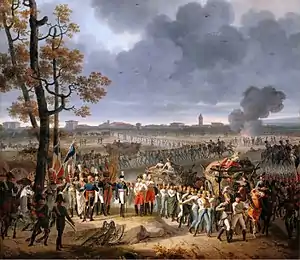Battle of Faenza
The Battle of Faenza, also known as the Battle of Castel Bolognese on February 3, 1797 saw a 7,000 troops from the Papal Army commanded by Michelangelo Alessandro Colli-Marchi facing 9,000 troops from the French Army under the command of Claude Victor-Perrin. The veteran French troops quickly overran the Papal army, inflicting disproportionate casualties. The town of Castel Bolognese was located on the banks of the Senio River 40 kilometres (25 mi) southeast of Bologna, and the city of Faenza was also nearby. The action took place during the War of the First Coalition, as part of the French Revolutionary Wars.
| Battle of Faenza | |||||||
|---|---|---|---|---|---|---|---|
| Part of the War of the First Coalition of the French Revolutionary Wars | |||||||
 A satirical depiction of the Papal Army before the Battle of Faenza. | |||||||
| |||||||
| Belligerents | |||||||
|
|
| ||||||
| Commanders and leaders | |||||||
|
|
| ||||||
| Strength | |||||||
| 9,000 | 7,000 | ||||||
| Casualties and losses | |||||||
| 100 killed or wounded |
800 killed or wounded 1,200 captured 14 artillery guns captured | ||||||
Background

The Siege of Mantua came to an end on February 2, 1797, when Austrian Field Marshal Dagobert Sigismund von Würmser capitulated to the army of General Napoleon Bonaparte. Only 16,000 members of the garrison were capable of marching out as prisoners of war. Leaving General Jean-Mathieu-Philibert Sérurier to oversee the surrender, Bonaparte invaded Romagna, which formed part of the Papal States.[1] The Papal army was led by Austrian Field Marshall-Lieutenant Michelangelo Alessandro Colli-Marchi,[2] a veteran of the Seven Years' War. Colli had served in the army of the Kingdom of Sardinia-Piedmont from 1793 to 1796 and had faced Bonaparte before in the disastrous Montenotte Campaign. He was an intelligent and capable officer, but sometimes had to be carried on a stretcher due to old wounds. The French Revolutionary Army was highly skilled, and fresh off recent successes in Italy. The Papal army, on the other hand, consisted of several “permanent regiments” and organized town or regionally trained militia battalions or cavalry squadrons called out in times of need. This was typical of many minor Italian state armies of this period including the Sardinian-Piedmontese army defeated by Bonaparte in 1796. The Papal army included several fortress garrison battalions, tasked with defending the state fortresses dotting the seacoast, ports and major towns.[3]
Battle
On February 3, Victor sighted Colli's troops on the Senio at Castel Bolognese near Faenza. The Papal artillery began firing upon the advancing French forces, inflicting casualties. The French army then launched an assault over the Senio, dispersing the Papal infantry and cavalry and capturing 14 artillery guns. The French army made short work of their adversaries- for a loss of 100 casualties, Victor's soldiers inflicted 800 casualties on the Papal troops. In addition, the French captured 1,200 men, 14 artillery pieces, eight caissons, and eight colors. Victor's corps included a grenadier reserve commanded by General Jean Lannes.[4][5]
Aftermath
The port of Ancona surrendered to Victor on 9 February with its Papal garrison of 1,200 men and 120 artillery guns. There were no French casualties. By the Treaty of Tolentino on 19 February, Pope Pius VI was forced to deliver works of art, treasures, territory, and[2] 30 million francs to France.[1]
In popular culture
The defeat was recorded not only by revolutionaries such as Francesco Saverio Salfi (who wrote a satirical pantomime about it),[6] but also with sarcasm by the reactionary count Monaldo Leopardi[7] and much later by his son, the poet Giacomo Leopardi.[8]
Notes
- Chandler (1966), 121
- Smith (1998), 133
- Boycott-Brown (2001), 135-136
- Smith (1998), 133. Smith gave the date as 3 February. He called Lannes a general of division.
- Broughton, Lannes. This source noted that Lannes was a general of brigade.
- Salfi, Colli
- Leopardi, M. Battaglia di Faenza
- Leopardi, G. Paralipomeni alla Batracomiomachia
References
- Boycott-Brown, Martin (2001). The Road to Rivoli: Napoleon's First Campaign. London: Cassell & Co. ISBN 0-304-35305-1.
- Broughton, Tony. "Generals Who Served in the French Army during the Period 1789-1815: Labadie to Lazowski". The Napoleon Series. Retrieved 17 April 2012.
- Chandler, David G. (1966). The Campaigns of Napoleon. New York, NY: Macmillan.
- Leopardi, Giacomo. Paralipomeni alla Batracomiomachia, Canto Primo, vols. 17-18 (in Italian).
- Leopardi, Monaldo. Autobiografia, vol. XXII "Battaglia di Faenza" (in Italian).
- Leopardi, Monaldo. Autobiografia, vol. XXIII "Presa di Ancona" (in Italian).
- Salfi, Francesco Saverio (1797). Il general Colli in Roma. Pantomimo eseguito dal cittadino Le Frève in Milano. V.R.F. / F.S. (PDF) (in Italian). Milan.
- Smith, Digby (1998). The Napoleonic Wars Data Book. London: Greenhill. ISBN 1-85367-276-9.